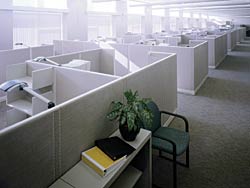Daylight in the Office Space
Natural Light and Heat
Natural light is a tremendous source of light and heat. As more natural light is designed into a space, project architects and design teams are challenged to ensure that the light and heat are appropriately controlled. Without control of natural light, those highly coveted views to the outdoors can cause disruption and discomfort, while sending the building's HVAC demand soaring. The glare, solar heat gain, and exposure to UV radiation caused by uncontrolled daylight can negatively impact occupant comfort, building performance, and interior fabrics and furnishings.
Glare and Brightness
The word brightness is used to describe the intensity of a light source. People perceive the brightness of an object in contrast with its surroundings. Car headlights on a clear sunny day are barely noticeable. The same car headlights on a dark stretch of highway can be so brilliant that they are uncomfortable to look at. Glare occurs when a light source or the reflection of a light source is significantly brighter (generally more than three times brighter) than the ambient light surrounding it, causing visual discomfort.
|
||||||||||||||
Visual discomfort is the result of the human eye's inability to adapt appropriately to the contrast in light intensities in its field of vision. Adaptation is a chemical process that takes place on the surface of the retina, regulating the eye's sensitivity to light. In bright environments, this sensitivity decreases, because more visual stimulus is available. In darker settings, sensitivities increase. The change in sensitivity is uniform across the eye, leaving few options to compensate for hot spots and areas of irregularity. If the sensitivity increases to read the brightest object, the surrounding areas are too lowly lit to be seen clearly. If the eye's sensitivity to light increases in order to interpret the surroundings, the intensity of the brighter object becomes glaring.
Accommodation is the physiological response that compensates for shortcomings in adaptation. Accommodation is the muscular process that limits the amount of light entering the eye by constricting the pupil and squinting. People can also accommodate their visual environments by lowering their heads and furrowing their brows. This is often an unconscious, automatic response, like blinking when the eyes are dry.
In an office space, both natural and electric light combine to create the light environment. Glass windows can deliver daylight into the workspace that ranges in quantity from a few hundred lux (lumens per square meter), on an overcast day, to over 10,000 lux on a clear sunny day. In contrast, the average light level recommended for an office space is between 300-500 lux, which is often what the electric light in the building is designed to provide. If the disparity between the intensities of the task lighting, the ambient light and the direct or reflected daylight in the employee's visual field is too great for the eye to accommodate through adaptation, glare occurs.
On a dark highway, the exposure to glare is brief and infrequent, lasting as long as it takes for the two cars to pass one another. In an office space, an employee could be subjected to glare for several hours nearly every day. Physically unable to adapt to glare conditions, employees and building occupants spend their days accommodating the visual environment with involuntary contractions of the pupil, squinting, modifying the position of their head, and furrowing their brows.
Repetitive use of these accommodation tactics can lead to stress injuries and muscle fatigue that manifest in the forms of eye strain, headaches, and computer vision syndrome. These problems are uncomfortable, fatiguing, and attribute to decreased productivity in the workplace.
Direct rays of sunlight are prone to causing glare, because their intensity has not yet been filtered or modified. One way of minimizing the threat of glare from natural light is to specify a device in the window that will either block, deflect, or diffuse direct sunlight. This reduces the intensity of the natural light entering the office space and the likelihood that glare-causing hot spots will occur.










